Here’s some more action shots of the same Kingfisher I posted a few days ago. This male at Farmington has been showing off for photographers and birders for several weeks now. I know it’s the same bird because this individual has a very small but distinctive white spot on the left side of the very tip of his bill that can be seen in the first two images below. That white spot is not found on the right side of his bill.
These shots were taken three days ago as the bird was fishing the creek below his favorite perch.
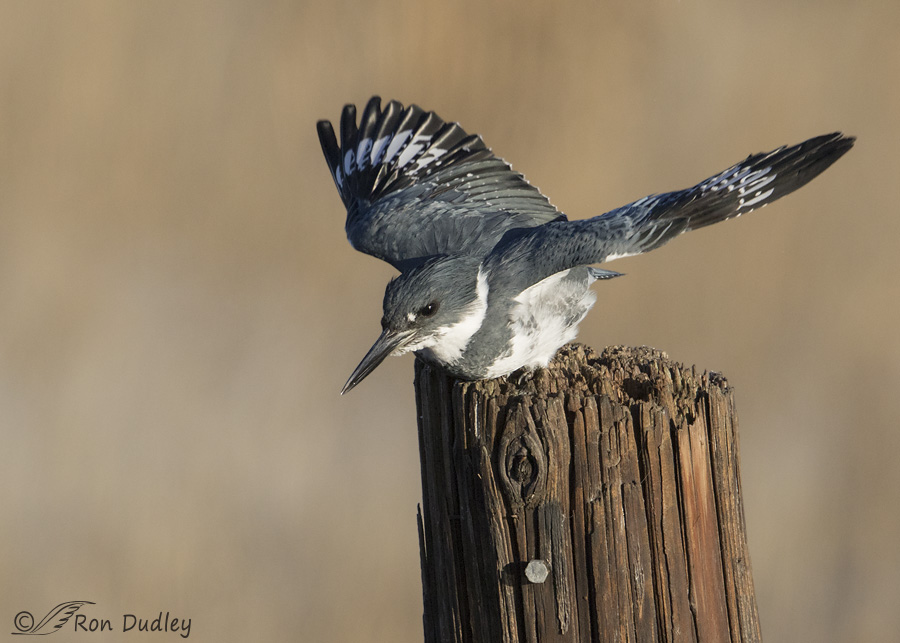
1/3200, f/7.1, ISO 1000, Canon 7D Mark II, Canon EF 500mm f/4L IS II USM + EF 1.4 III Extender, not baited, set up or called in
I quickly tired of photographing him resting on the post so my goal was to get takeoff and landing shots but these birds are unusually quick for their size so it wasn’t easy. Here he’s about to begin his powered dive down into the water after a fish. This time of morning he’s always side-lit so I was pleased that this pose allowed me to get light on almost the entire visible surface of the bird.
On most days the old wooden post he likes to fish from is pretty bright but it had rained during the night so it was still wet and much darker than usual. I like the effect.
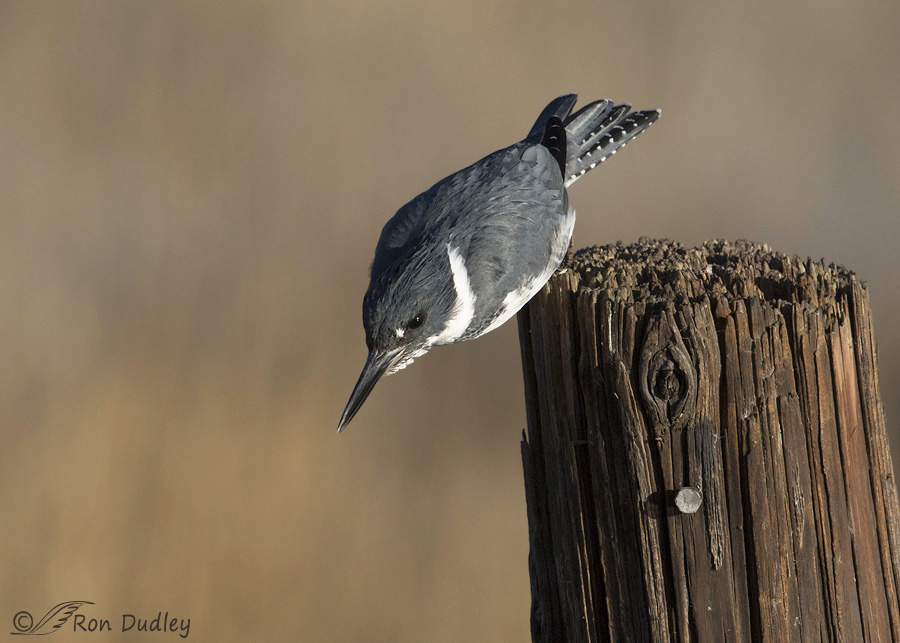 1/3200, f/7.1, ISO 1000, Canon 7D Mark II, Canon EF 500mm f/4L IS II USM + EF 1.4 III Extender, not baited, set up or called in
1/3200, f/7.1, ISO 1000, Canon 7D Mark II, Canon EF 500mm f/4L IS II USM + EF 1.4 III Extender, not baited, set up or called in
Several minutes later on a different dive I caught him with his wings still folded as he launched mostly by pushing off with his stubby little legs. This bullet-shape must be the profile that enters the water at speed so I imagine it would be quite effective at allowing the bird to reach its underwater prey.
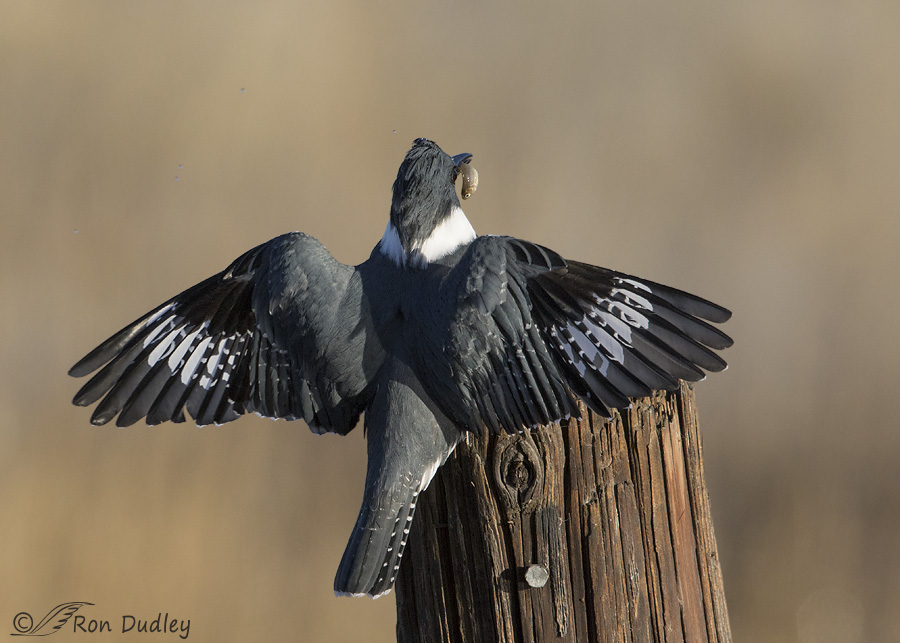
1/3200, f/7.1, ISO 640, Canon 7D Mark II, Canon EF 500mm f/4L IS II USM + EF 1.4 III Extender, not baited, set up or called in
The dive was successful but when he returned to the post to enjoy his snack he had his back to me. At least we can see the fish and this view provides a pretty good look at his dorsal plumage colors and patterns.
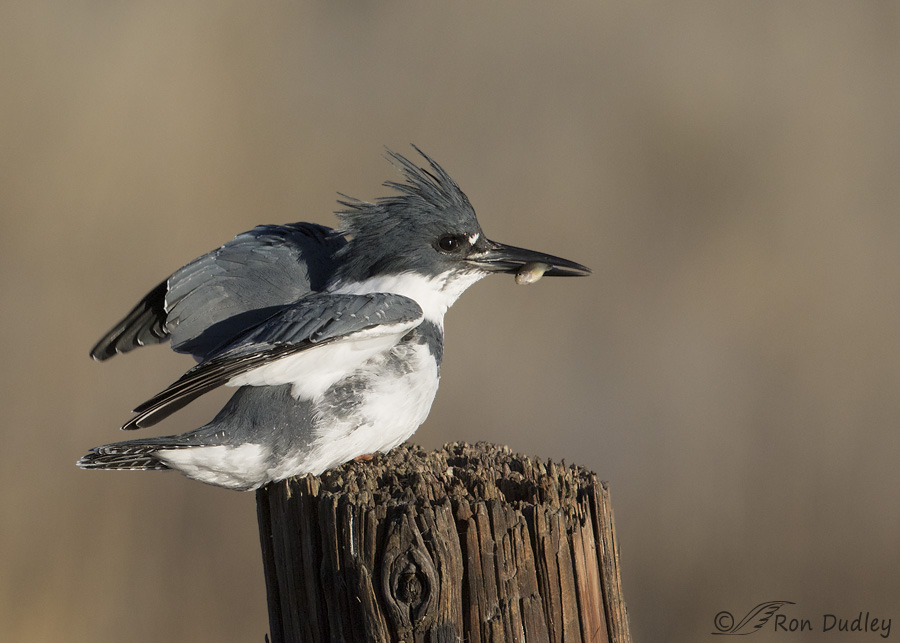
1/4000, f/7.1, ISO 640, Canon 7D Mark II, Canon EF 500mm f/4L IS II USM + EF 1.4 III Extender, not baited, set up or called in
In my experience when the fish is a fairly large one they usually beat it senseless against the perch to stun or kill it before gulping it down. But with these smaller fish they just shake them vigorously a few times before swallowing…
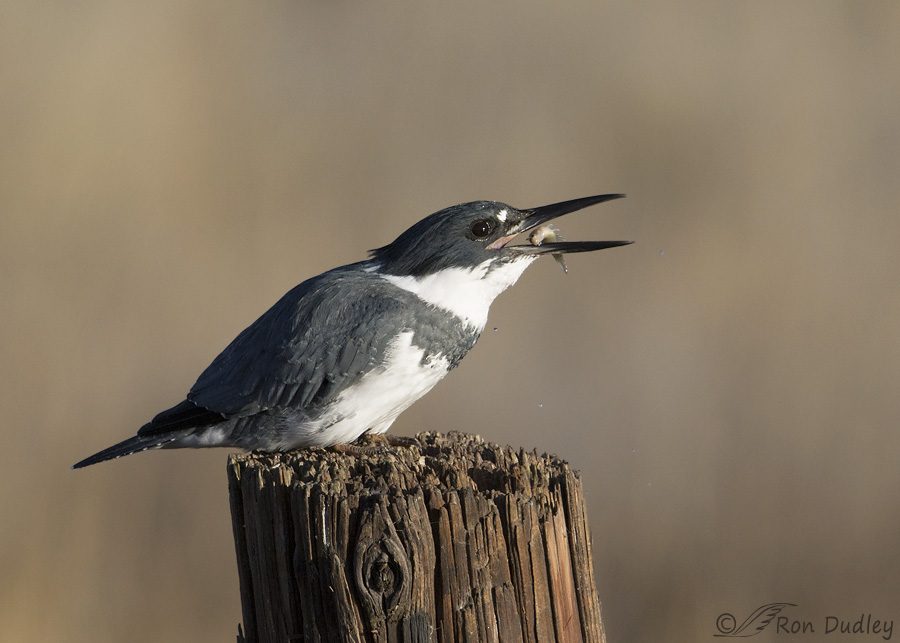
1/3200, f/7.1, ISO 640, Canon 7D Mark II, Canon EF 500mm f/4L IS II USM + EF 1.4 III Extender, not baited, set up or called in
so it didn’t take long for this little fish to disappear down the hatch.
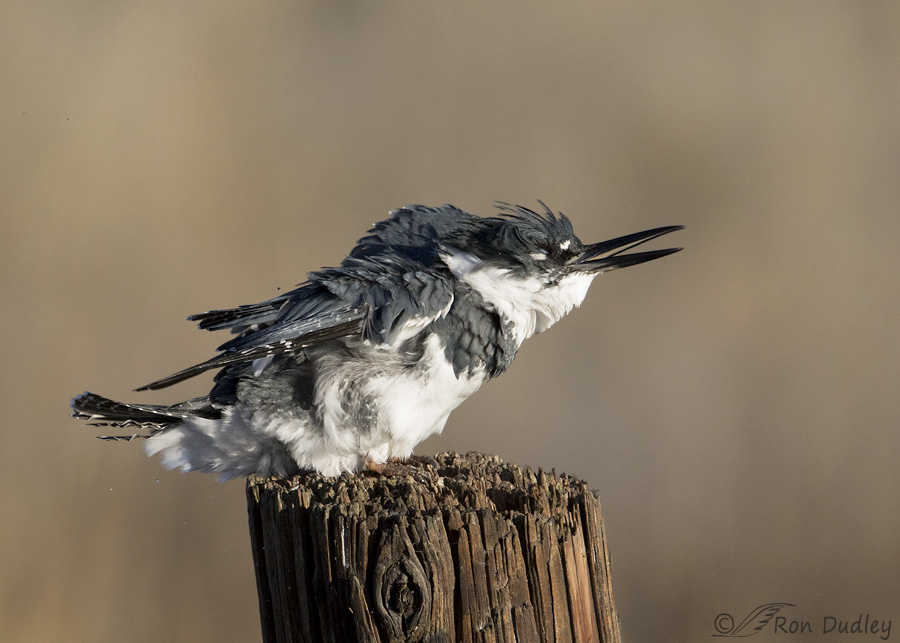
1/3200, f/7.1, ISO 640, Canon 7D Mark II, Canon EF 500mm f/4L IS II USM + EF 1.4 III Extender, not baited, set up or called in
Then he gave every feather on his body a very rambunctious ride as he shook (roused) enthusiastically. The membrane-covered eye can barely be seen – it’s the slanted gray-blue structure between the two white spots. Birds nearly always close their nictitating membranes while rousing in order to protect the eye.
It’ll be interesting to see how long this bird sticks around this winter. During mild winters some kingfishers are here year-round but if all the ponds and streams ice over they usually leave. We badly need a cold and snowy winter but if it doesn’t happen this bird may be the consolation prize.
Ron


Glad to hear the tree limb missed the chimney. I don’t even want to think of the 1-2 punch that would have been with your refrigerator. Here’s hoping the snow blocked any damage to your shingles too.
These are all great action shots. You make it near impossible to pick a favorite.
Using Laura’s WOW!!!! here.
Love the bullet trajectory, and the rousing shot.
Thank you.
Thank you, EC.
That “rouse” shot ( the last in the series ) made me laugh out loud ! He looks he was hit by a tornado……..
I agree, Kris. He really got into his shaking this time.
Wonderful series of a flying torpedo…very relieved to hear roof seems to be OK and treelimb missed the chimney…
My relief was palpable, Patty. My life’s complicated (and expensive) enough right now as it is!
Wonderful series Ron!
charlotte
Thanks, Charlotte.
Wonderful series! I’m surprised at how detailed the upper wing markings are. To me the rousing behavior immediately following swallowing the fish looks like maybe he was regretting eating the fish – like it didn’t taste very good… (I know that’s not why he did it.)
I’m surprised no visible water flew off of him when he roused, Susan.
Bullet bird for sure…great captures!! That shake looks vigorous.
It was, Zaphir! Thanks.
Love the Belted Kingfisher images Ron. The last one of it rousing is very interesting.
There are a few of them sticking around the ponds by my home. These ponds do not always have water in them so I am curious what the kingfishers are fishing for? Perhaps tadpoles and salamanders? I think the ponds you are photographing at Farmington Bay have year round water?
“I think the ponds you are photographing at Farmington Bay have year round water?”
Not always, Ed. Most often they do but when it gets very cold even the pond at the 4-way completely freezes over.
Kingfishers can be quite opportunistic when water and fish aren’t available. Among other things they also eat “molluscs, crustaceans, insects, amphibians, reptiles, young birds, small mammals, even berries” (from BNA Online).
Interesting. Thank you Ron.
Beautiful series, Ron! The rousing sure does get all those feathers up! At least he didn’t lose the fish by tossing it this time,
The rousing sure does get all those feathers up! At least he didn’t lose the fish by tossing it this time,  Glad the roof damage appears to be minimal.
Glad the roof damage appears to be minimal. 
Judy, I think the roof might be ok. I was able to remove the big limb that fell but all the snow never quite melted so I can’t see if there are any punctures in the shingles yet. Apparently there’s no major damage though so I’m very happy about that. The heavy limb barely missed my brick chimney!
Wonderful images, Ron. I love the bullet dive.
Thank you, Sharon.